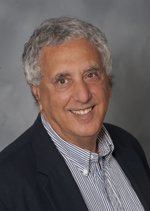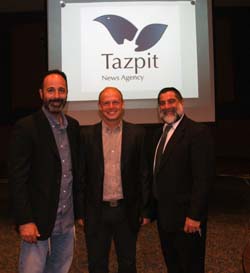By Donald H. Harrison


SAN DIEGO—Why do Palestinians seem to get better press than Israelis in Western media? Journalistic bias is only part of the answer, Amotz Eyal, the founder of the Tazpit News Agency of Israel, told a gathering Sunday night, May 4, at Beth Jacob Congregation.
In a slide and video presentation, Eyal said three factors contribute to pro-Palestinian coverage. These are news manipulation, “bending the truth,” and what, until recently, was a lack of countervailing information.
On the screen flashed a photo of an Israeli soldier seemingly pointing a rifle at a small child. But closer examination shows that the soldier is not aiming the rifle, that it is slung over his chest. The camera angle made it look as if it were being pointed.
Then there was a video of Jewish settlers throwing stones. Not shown in the footage are Arabs who, in fact, are also throwing stones in a battle between the two sides.
The photo and the footage were shot by pro-Palestinians seeking to influence public opinion in the West, said Eyal.
Another instance showed six cars belonging to Palestinians that had been torched. The media coverage said Jewish settlers were behind it. The truth, according to Eyal, was that the cars were set afire by two feuding clans in an Arab village.
Another story in the Western news media told of settlers chopping down Arab olive trees in an act of vengeance. The truth, reported Eyal, was that the trees were cut down by the Arabs themselves. Tazpit had a picture of one of the choppers. Eyal said there are many reasons to chop down an olive tree. If it is sick and it is chopped down, it will grow back healthier. It provides firewood. And perhaps, most importantly, if the blame for chopping down the tree can be pinned on an Israeli settler, the tree’s owner will receive compensation both from the Palestinian Authority and from Israel.
“Bending the truth” is a slightly different propaganda technique involving omitting important facts, Eyal said. For example, there was a photo story of stone throwers being shot by an Israeli soldier. The IDF does not permit its troops to respond to stone throwing with bullets. Eyal said Tazpit’s coverage of the same event revealed that the Arabs in question not only had rocks, they were carrying hand grenades.
In another instance, a man involved in an altercation was painted as an extremist settler– but omitted from the story was the fact that he was a well known medical clown who entertained sick Palestinian and Israeli children, Eyal said.
A third factor – and the one that Tazpit News Agency was created to combat –was a lack of countervailing information from Israeli Jews. While Palestinians have nine news services to pump out stories from the disputed territories, which Eyal alternately referred to as “the West Bank” and “Judea and Samaria,” Israelis had none, up to the point that the Tazpit News Agency was created. So whenever Palestinians would issue a story about some supposed Israeli outrage, all Israel could do was respond to it. There was no independent coverage on the Israeli side.
By mobilizing volunteer reporters and photographers from Jewish cities and settlements throughout the West Bank, Tazpit not only can provide coverage of the same demonstrations that the Palestinians create for the news media, it also can provide to western news media on-the-spot photos and stories that are not otherwise available.
He flashed onto the screen a picture of a Nazi flag flying next to a mosque in an Arab village – a photo that had been carried all over the world.
If a Tazpit photographer had not happened by the scene, this display of Palestinian hatred for the Jews would have gone unreported, he said.
On came another photo, of a Jew who had been beaten within an inch of his life by an Arab gang. “If we weren’t able to photograph it, no one would have known,” he said.
Besides the Israeli side of the conflict, there are other kinds of story that Palestinian propagandists don’t want Westerners to read, he said.
Those are the stories of medical teams from Israeli settlements regularly coming to the aid of Palestinians who have been in traffic accidents or suffer medical emergencies. Similarly, they are stories of amicable relationships between Jews and Palestinians.
On one occasion, Eyal said, a reporter from the Netherlands called him and asked if he could see the “apartheid” of the West Bank. Eyal took him to see Arabs and Jews working and socializing together.
“This is not apartheid,” said the Dutch reporter. “Yes, you said it,” Eyal replied.
By creating the Tazpit News Agency, Eyal said Israelis living beyond the Armistice Lines of the 1948 Independence War can illustrate the realities of life on the West Bank. The agency’s stories are carried by news services and news publications all over the world, including on San Diego Jewish World, where the photos and stories of Tazpit reporters Anav Silverman and Aryeh Savir have become familiar to regular readers.
Besides making its stories available to the worldwide news media, Tazpit has set up a service to take foreign reporters around Judea and Samaria, so they can see for themselves what is happening. Up to the time the service was created, he said, journalists only had the option of going on their own or with Palestinian guides to the disputed territories. These Palestinian driver/ guides take journalists to favorite places and interpret interviews for them, Eyal said. In contrast, said Eyal, Tazpit guides will take the journalists anywhere they wish to go without trying to control their stories.
Soon, Tazpit will be offering 30 journalistic internships for students from other countries so they can witness the realities of the journalistic situation in Israel, Eyal said.
The generally friendly crowd at the Orthodox congregation asked how Tazpit is financed. ‘Money,” said Eyal, “is always a problem.” There are private donors helping, he said, adding that Tazpit does not need as much money as the Arab propagandists. He said Tazpit photographers take news photos as they occur, and distribute them immediately. He said there is no need for film editors to manipulate the footage.
Eyal’s presentation concluded humorously with a slide of Abraham Lincoln and a facetious caption saying that the 16th U.S. President had warned people against giving automatic credence to pictures and captions they see on the Internet. Given that Lincoln died perhaps a century before the Internet was invented, the caption proved its own satiric point.
*
Harrison is editor of San Diego Jewish World. He may be contacted at donald.harrison@sdjewishworld.com